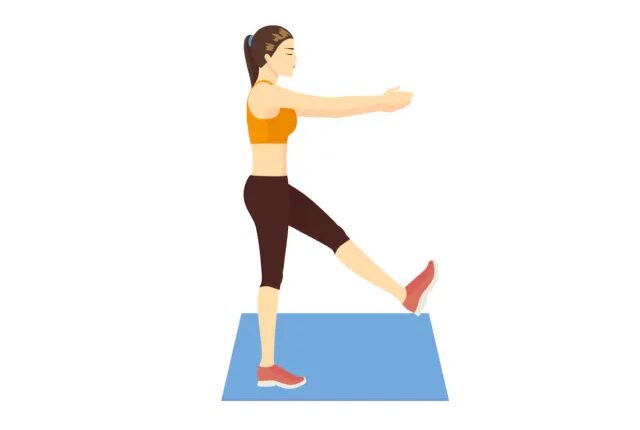Balance plays a vital role in overall fitness, benefiting not only tightrope walkers and yogis but also anyone performing regular daily activities like walking, climbing stairs, playing sports, or lifting weights. Aside from helping prevent injuries, good balance enhances coordination and physical performance, making it a crucial but sometimes neglected element of fitness that should receive more focus in your workout routine. Here, we’ve compiled a selection of top balance exercises that can assess your current level of fitness.
Balance naturally declines as you age, increasing the risk of falls and injuries. Incorporating balance exercises into your routine can counteract this decline, enhancing your stability and overall quality of life. Whether you’re an athlete aiming to elevate your performance or want to move more confidently and securely through daily activities, working on your balance offers substantial benefits.
Ready to test your performance? These 10 balance exercises can help you assess and improve your stability, ensuring you’re in good, if not even great, shape. Each exercise challenges your balance differently, delivering a well-rounded approach to this essential fitness component.
If you can master these balance exercises, you’ll be well on your way to achieving better balance and overall fitness!
Single-leg Stand
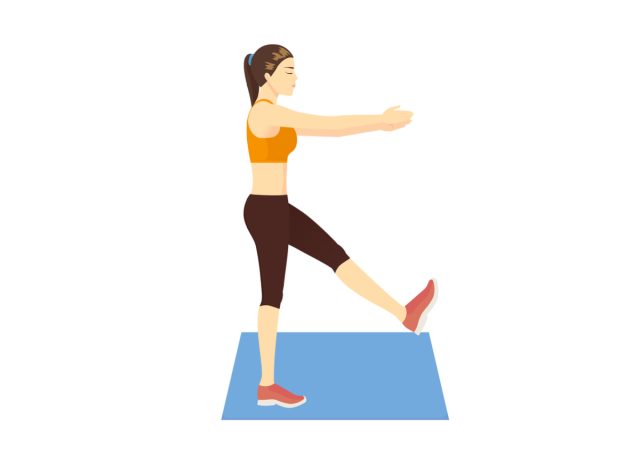
The single-leg stand is a fundamental balance exercise that tests your static balance and lower-body stability. It’s beneficial for identifying imbalances between your left and right sides.
This exercise engages the stabilizing muscles in your ankles, knees, and hips, promoting joint health and reducing the risk of injuries. Additionally, it enhances proprioception, which is your body’s ability to sense its position in space, which is crucial for maintaining balance and coordination in everyday activities and athletic pursuits.
Stand tall with your feet together. Lift your right foot off the ground and bend your knee to form a 90-degree angle. Hold this position for 30 seconds to a minute without letting your hips tilt or your standing knee wobble. Switch to your left foot and repeat. To increase the difficulty, try closing your eyes or standing on an unstable surface like a foam pad.
Tree Pose
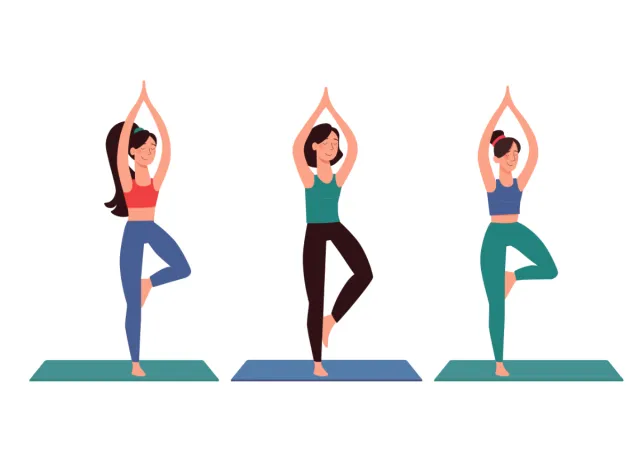
A staple in yoga, the tree pose improves static balance, focus, and proprioception and strengthens the muscles around your ankles and knees. By requiring you to balance on one leg while maintaining a specific posture, the tree pose enhances your mental concentration and mindfulness.
It encourages proper alignment and posture, which can translate to better overall body mechanics. Additionally, the tree pose stretches the groin, inner thighs, chest, and shoulders, contributing to flexibility and muscle balance.
Stand with your feet together and your arms at your sides. Shift your weight onto your left foot and place the sole of your right foot against your inner left thigh or calf (avoid placing it directly on the knee). Bring your hands together in front of your chest in a prayer position. Hold for 30 seconds to a minute, then switch sides. For an added challenge, extend your arms overhead or close your eyes.
Single-leg Romanian Deadlift (RDL)
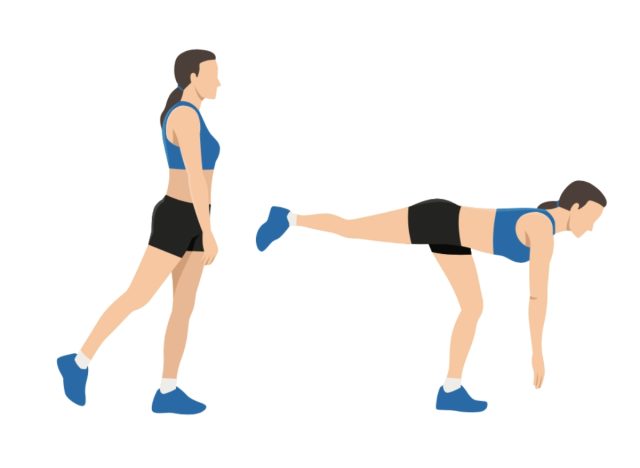
The single-leg RDL targets your hamstrings, glutes, and core while challenging your dynamic balance. It’s excellent for improving stability and strength in the posterior chain. This exercise enhances hip mobility and can help correct muscular imbalances that often lead to injuries.
By engaging your core muscles throughout the movement, the single-leg RDL promotes better posture and alignment, reducing the strain on your lower back. This exercise is particularly beneficial for athletes, as it mimics the movements required in many sports that involve running, jumping, and changing directions.
Stand on your right leg with a slight bend in the knee. Hinge at your hips, extending your left leg straight behind you while lowering your torso toward the ground. Keep your back flat and your hips squared to the floor. Reach your hands toward the ground or hold a weight for added resistance. Return to the starting position and repeat for eight to 12 reps before switching legs.
Split Squat
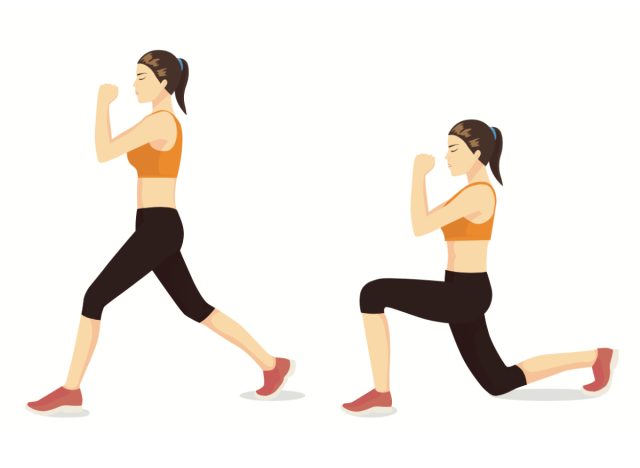
The split squat enhances lower-body strength and balance, particularly in the quadriceps and glutes. It also helps improve hip mobility and stability. This exercise isolates each leg, allowing you to focus on developing unilateral strength, which can help correct muscular imbalances and improve overall leg strength.
By requiring you to stabilize your body in a split stance, the split squat engages your core muscles and promotes better balance and coordination. It’s a versatile exercise you can modify with weights or varying stances to target different muscle groups and intensities.
Start in a staggered stance with your right foot forward and left foot back, about two feet apart. Lower your body until your right thigh is parallel to the ground and your left knee nearly touches the floor. Keep your torso upright and your front knee aligned over your ankle. Push through your right heel to return to the starting position. Perform eight to 12 reps before switching legs.
Single-leg Squat to Box
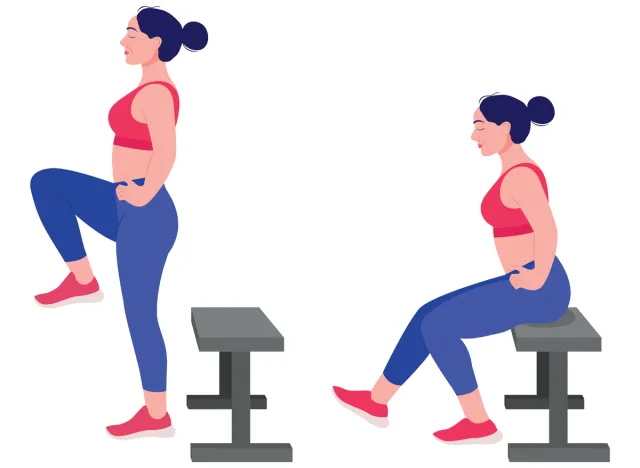
This exercise improves single-leg strength, balance, and coordination. It also helps identify and correct imbalances between your legs. You engage your quadriceps, hamstrings, glutes, and calves by performing a controlled squat on one leg, enhancing lower body strength and stability.
The single-leg squat to box also challenges your core muscles to maintain proper alignment and balance, reducing the risk of lower back strain. This exercise can improve your performance in activities that require unilateral strength and stability, such as running, jumping, and changing directions.
Stand on your right leg in front of a box or bench. Slowly lower yourself into a squat, lightly tapping your glutes on the box. Keep your left leg extended in front of you and your torso upright. Push through your right heel to return to the starting position. Perform six to 10 reps before switching legs. Start with a higher box and gradually decrease the height as you get stronger.
Single-arm Plank
The single-arm plank challenges your core stability and upper-body strength and tests your ability to maintain balance with asymmetrical loading. Lifting one arm off the ground forces your core muscles, particularly the obliques and transverse abdominis, to work harder to stabilize your body.
This exercise also engages your shoulders, chest, and back muscles, promoting upper-body strength and endurance. The single-arm plank improves your coordination and balance, making it an excellent addition to any functional training routine.
Begin in a standard plank position with your hands directly under your shoulders and your body in a straight line. Lift your right hand off the ground and extend it straight before you or keep it by your side. Hold for 10 to 20 seconds, keeping your hips level and your core engaged. Switch to your left hand and repeat. To increase the difficulty, try lifting the opposite leg simultaneously.
Suitcase Carry
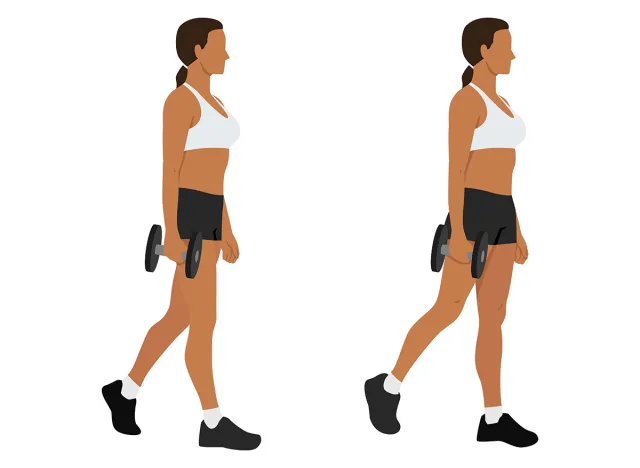
The suitcase carry tests your dynamic balance, grip strength, and core stability. It mimics carrying a heavy object in one hand, which requires significant stabilization. This exercise engages your obliques, shoulders, and grip muscles, promoting overall functional strength.
The suitcase carry also improves your posture by encouraging you to maintain an upright position while carrying an asymmetrical load. It’s a practical exercise that enhances your ability to perform everyday tasks, such as carrying groceries or lifting objects, with better balance and reduced risk of injury.
Hold a heavy dumbbell or kettlebell in your right hand at your side. Stand tall with your shoulders back and your core engaged. Walk forward for 30 to 50 feet, maintaining an upright posture and avoiding leaning or twisting. Switch hands and repeat. Focus on keeping your steps controlled and even.
Heel-to-Toe Walk
This exercise enhances dynamic balance and coordination, making it particularly useful for improving gait and stability. The heel-to-toe walk engages the muscles in your lower legs and feet, promoting strength and endurance in these areas.
This exercise challenges your proprioception and spatial awareness by requiring you to place one foot directly in front of the other, helping you maintain better balance and coordination. The heel-to-toe walk is an excellent exercise for older adults or anyone looking to improve their walking mechanics and reduce the risk of falls.
Stand with your feet together. Step forward with your right foot, placing your heel directly before your left toe. Continue walking straight, placing each heel directly before the opposite toe. Keep your eyes forward and your arms at your sides or extended for balance. Perform for 20 to 30 steps.
Lateral Shuffle
The lateral shuffle improves lateral movement, agility, and dynamic balance. It’s excellent for athletes who need to move quickly in different directions. This exercise engages your hip abductors, adductors, and quadriceps, promoting strength and stability in these muscle groups.
The lateral shuffle also enhances cardiovascular fitness and coordination, making it an excellent addition to high-intensity interval training (HIIT). By improving your ability to move laterally, this exercise can enhance your performance in sports and activities that require quick direction changes, such as basketball, tennis, and soccer.
Stand with your feet shoulder-width apart and your knees slightly bent. Shuffle to your right by pushing off your left foot and stepping your right foot to the side. Follow with your left foot, keeping your feet apart and your movements quick and controlled.
Shuffle for 10 to 20 feet, then switch directions. Perform for 30 to 60 seconds.
Three-way Toe Taps
This exercise tests your balance and proprioception in multiple directions. It strengthens your ankles, calves, and core. Tapping your toes in different directions challenges your ability to maintain balance while shifting your weight, promoting better coordination and stability.
The three-way toe taps engage your hip flexors, glutes, and lower leg muscles, enhancing overall lower-body strength and endurance. This balance exercise is particularly beneficial for improving your ability to perform multi-directional movements, such as those required in sports and daily activities.
Stand on your right leg with a slight bend in the knee. Tap your left toes forward, to the side, and then behind you, returning to the starting position after each tap. Keep your torso upright and your movements controlled. Perform eight to 12 taps in each direction before switching legs.
Frequently Asked Questions (FAQs) About Balance Exercises
Why are balance exercises important?
Balance exercises help improve stability and coordination, reduce the risk of falls, strengthen muscles, and enhance overall physical fitness. They are crucial for maintaining good posture and preventing injury, especially as we age.
Who can benefit from balance exercises?
Everyone can benefit from incorporating balance exercises into their workout routine. They are particularly beneficial for older adults looking to improve stability and reduce the risk of falls. Athletes can also benefit from balance training to enhance performance and agility.
How often should balance exercises be performed?
Ideally, balance exercises should be done 2-3 times a week to see improvement in stability and coordination. It’s essential to include a variety of exercises that challenge different aspects of balance, such as static and dynamic movements.
Can balance exercises be done at home?
Yes, many balance exercises can be done at home with minimal equipment. Simple exercises like standing on one foot, heel-to-toe walk, or practicing yoga poses can help improve balance. However, for added variety and challenge, one can use balance boards, stability balls, or wobble cushions.
Are there any precautions to consider when doing balance exercises?
- Avoid doing balance exercises on unstable surfaces if you have existing joint problems or injuries.
- Start with easier exercises and gradually progress to more challenging ones as your balance improves.
- Always have a support nearby, such as a wall or chair, especially if you are new to balance training.
- If you have a medical condition or concerns about your balance, consult with a healthcare provider before starting any new exercise regimen.

